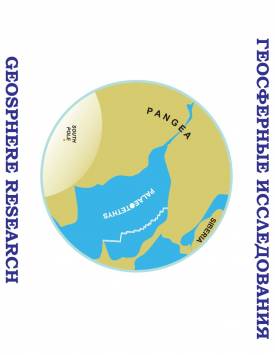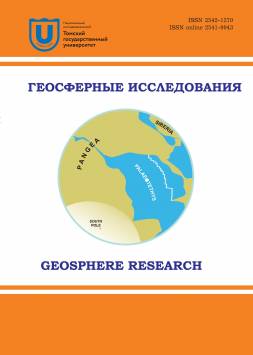Pollution of Lake Baikal littoral surface waters in the zone of influence of waste water from the Baikalsk town wastewater treatment facilities: assessment by geochemical method
The assessment of impact of anthropogenic and natural pollution sources onto water objects is one of important ecological tasks. In this work, we developed a numeric method for calculation of water fractions from the sources illustrated by Lake Baikal littoral in the zone of influence of wastewaters from treatment facilities (WTF) in Baikalsk town. The method is based on use of a wide spectrum of chemical elements measured in the sources (waste, riverine and Baikalian waters) and mixing objects (littoral waters) and is a first stage of a developed earlier geochemical method for assessment of the influence of local pollution sources onto water objects. The calculation of water fraction from the sources is performed by several groups of contrast conservative and conventionally conservative chemical elements using iteration procedures minimizing a standard deviation of measured concentration of chemical elements in mixing objects from calculated ones. At the second stage, geochemical fractions from pollution sources are calculated taking into account a probable non-conservative behave of chemical elements at physico-chemical and biogeochemical barriers. Waste waters from Baikalsk town WTF are discharged into an Aerator Pond situated at Lake Baikal coast. The wastes income from the Aerator Pond via drainage stations along subaqual pipes into Lake Baikal and are discharged at the depths of 12-44 m in ~ 140 from water edge. It is found that water fraction from Baikalsk town WTF in coastal water of the lake in the zone of influence of BPPP Aerator Pond is 3.4 ± 03 % suggesting ground leakages, which are probably due to disturbance of consistency of the collector construction. Main sources of coastal waters formation are Baikal water (56 ± 4 %) and the Bol’shaya Osinovka R. (41 ± 4 %), the mouth of which is situated in 180 m eastward from the Aerator Pond. In Lake Baikal littoral surface water in the zone of influence of subaqual pipes for wastewaters discharge in the sectors of ~ 145 and ~ 190 m from water edge, water fractions from wastewaters are 0.034-0.19 %, ones of riverine waters are - 1.7-2.1 %, ones of Baikalian waters are ~ 98 %. Among the studies objects, the most geochemically influenced by wastewaters from Baikalsk town WTF one is Lake Baikal coastal water opposite to the Aerator Pond - summary geochemical fractions of waste waters calculated as a sum of fractions by 31 informative chemical elements is here 561 %, this is more by one order of magnitude than in the surface water above the head walls of discharge subaqual pipes in the sector of ~ 145 m from the water edge (50-55 %) and in a more remote sector of ~ 190 m from water edge (14-71 %). Analogous characteristics calculated by 12 normative chemical elements are 261 %, 26-29 % and 8-37 %, respectively. In Lake Baikal coastal water, the most important are geochemical fractions of waste waters by Mn, Cl, Ga and Ge (69-51 %), a grade below belongs to B (45 %) and P (39 %), then Rb (24 %), Na (22 %) and K (24 %), then Cs, Fe, Li, Ni, Cr, V, Co and Sb (18-10 %). Fractions of other elements are < 10 %. In the lake surface water in the zone of influence of subaqual pipes for wastewaters discharge in the sectors of ~ 145 and ~ 190 m from water age, their geochemical fractions are the most important by Mn (5.3-23 %) and Ga (3-14%), less - by Ge (1.2-6.1 %), Cl (1.1-5.6 %), B (0.57-3.1 %), P (0.42-2.3 %), Rb (0.34-1.8 ), Cs (0.27-1.5 %), Cr (0.23-1.3 %), Si, K (0.23-1.2 %), Fe (0.2-1.1 %) and Na (0,19-1 %). Fractions of other elements are < 1 %. We found in waste waters from Baikalsk town WTF the normatives exceed by Fe (158 MAC), P (67 MAC), Cl (37 MAC), Al (13 MAC), Cr (7.4 MAC), K (6 MAC), Na (5.6 MAC), Ni (4.8 MAC), S (3,3 MAC), Pb (1.6 MAC), Mn (1.6 MAC) and Mo (1.3 MAC) established for wastewaters discharged directly into Lake Baikal. The proposed method may be recommended for the assessment of a degree of geochemical impact of local pollution sources onto aquatic objects and expanded to any other pollutants at their common determination. Contribution of the authors: Chebykin E.P. - sampling and multi-element ICP-MS analysis of water samples; search and analysis of scientific publications; development of a geochemical method for solving the tasks set; preparation of graphic material and writing of the manuscript, final conclusions. Kulikova N.N. - field work; development of the concept of biogeochemical research; writing individual parts of the manuscript. Likhoshway Ye. V. - scientific management; problem statement; organization of the expedition; editing the manuscript; final conclusions. Suturin A.N. - scientific management; research concept; conclusions. The authors declare no conflicts of interests.
Keywords
waste waters, chemical elements, ICP-MS, maximal allowable concentrations, Lake BaikalAuthors
| Name | Organization | |
| Chebykin Eugene P. | Limnological Institute, RAS SB | epcheb@yandex.ru |
| Kulikova Natalya N. | Limnological Institute, RAS SB | kulikova@lin.irk.ru |
| Likhoshway Yelena V. | Limnological Institute, RAS SB | likhoshway@mail.ru |
| Suturin Alexander N. | Limnological Institute, RAS SB | san@lin.irk.ru |
References

Pollution of Lake Baikal littoral surface waters in the zone of influence of waste water from the Baikalsk town wastewater treatment facilities: assessment by geochemical method | Geosphere Research. 2025. № 2. DOI: 10.17223/25421379/35/13
